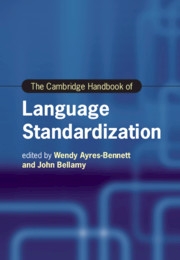Book contents
- The Cambridge Handbook of Language Standardization
- cambridge handbooks in language and linguistics
- The Cambridge Handbook of Language Standardization
- Copyright page
- Contents
- Figures
- Tables
- Contributors
- Introduction
- Part I Revisiting Models and Theories of Language Standardization
- 1 Modelling Language Standardization
- 2 Language Standardization ‘from Above’
- 3 Language Standardization in a View ‘from Below’
- 4 Social Cohesion and Emerging Standards of Hindi in a Multilingual Context
- 5 Standardization in Highly Multilingual National Contexts
- 6 Standardization of Minority Languages
- Part II Legitimacy, Authority and the Written Form
- Part III Norms, Literacy and Education
- Part IV Beyond the National
- Part V Standardization in Late Modernity
- Name Index
- Subject Index
- References
2 - Language Standardization ‘from Above’
from Part I - Revisiting Models and Theories of Language Standardization
Published online by Cambridge University Press: 01 July 2021
- The Cambridge Handbook of Language Standardization
- cambridge handbooks in language and linguistics
- The Cambridge Handbook of Language Standardization
- Copyright page
- Contents
- Figures
- Tables
- Contributors
- Introduction
- Part I Revisiting Models and Theories of Language Standardization
- 1 Modelling Language Standardization
- 2 Language Standardization ‘from Above’
- 3 Language Standardization in a View ‘from Below’
- 4 Social Cohesion and Emerging Standards of Hindi in a Multilingual Context
- 5 Standardization in Highly Multilingual National Contexts
- 6 Standardization of Minority Languages
- Part II Legitimacy, Authority and the Written Form
- Part III Norms, Literacy and Education
- Part IV Beyond the National
- Part V Standardization in Late Modernity
- Name Index
- Subject Index
- References
Summary
Language standardization ‘from above’ occurs in situations in which language authorities seek to disseminate a standardized variety across a speech and writing community. Hence, the crucial aspect of language standardization ‘from above’ is implementation, in Haugen’s terminology. In the history of many European languages, standardization ‘from above’ is a Late Modern phenomenon, closely tied to the rise of standard language ideology in the eighteenth century. In this chapter, we first define language standardization ‘from above’, situating it in the sociohistorical context of the eighteenth and nineteenth centuries. Arguing that the sociolinguistic situation at the time can be described as diaglossic, we claim that language standardization ‘from above’ is a top-down effort to reorganize the sociolinguistic condition in terms of standard and non-standard. We then discuss various instruments of implementation, encompassing both private and official language planning activities such as usage guides, language academies, professorships in ‘national’ languages, language laws and educational reforms. Finally, we zoom in on the effects of implementation, distinguishing between discursive and linguistic effects (i.e. changing patterns of language use under the influence of standardization ‘from above’). Our examples are mainly taken from the Dutch situation, while also incorporating examples from English, German, French and Spanish.
Keywords
- Type
- Chapter
- Information
- The Cambridge Handbook of Language Standardization , pp. 65 - 92Publisher: Cambridge University PressPrint publication year: 2021
References
- 5
- Cited by



